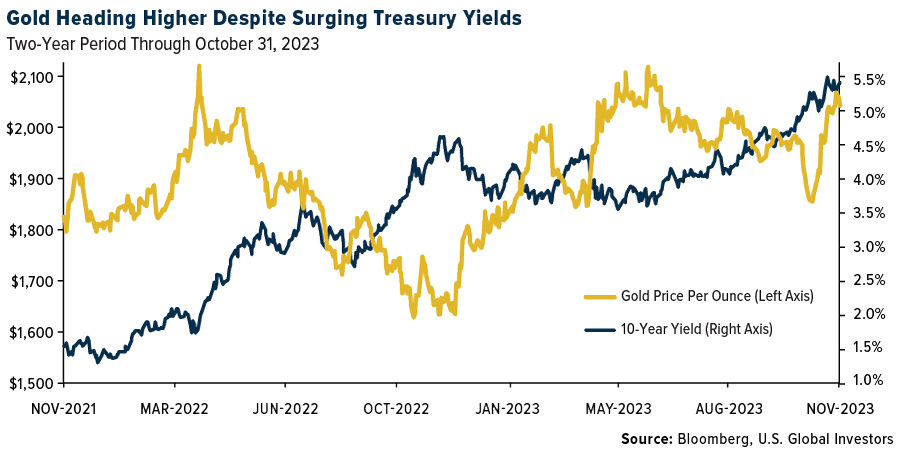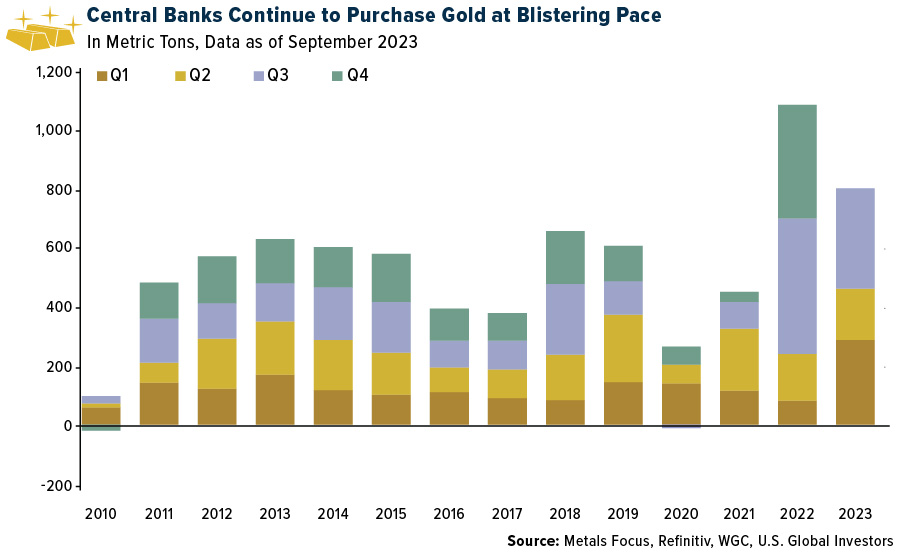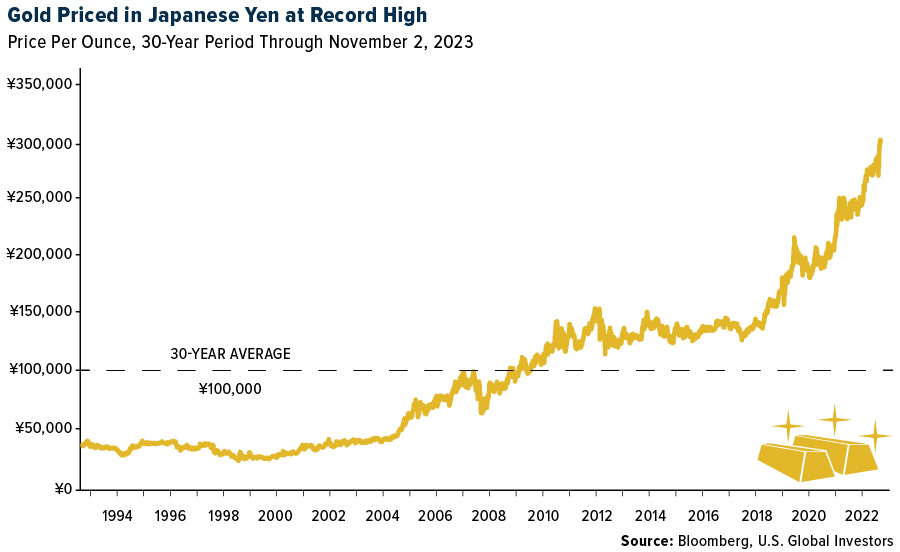Send this article to a friend:
November
09
2023
Send this article to a friend: November |
Gold Prices Record Their Strongest October Surge In Nearly Half A Century
The price of gold had its best October in nearly half a century, defying tough resistance from surging Treasury yields and a strong U.S. dollar. The yellow metal rallied an incredible 7.3% last month to close at $1,983 an ounce, its strongest October since 1978, when it jumped 11.7%. Gold, a non-interest-bearing asset, has historically floundered when bond yields were heading higher. An exception has been made this year, however, on a number of significant economic and geopolitical risks, including record-high national debt, rising credit card delinquencies, ongoing recession jitters (despite Jerome Powell’s insistence that a recession is no longer in the Federal Reserve’s forecasts) and two wars.  Crafting Your Gold Portfolio In An Uncertain Market If you believe these conditions will continue to spur investment demand for gold, now may be a good time to consider getting exposure (or adding to your exposure) in anticipation of potentially higher prices. A word of caution: The metal looks overbought right now based on the 14-day relative strength index (RSI), so we may see some profit-taking in the short term. I believe strong support is being established, and if stocks recede from last week’s pump, it may be an adequate catalyst for a gold rally. Keep in mind that, for the 30-year period, November has been the best month for stocks, with the S&P 500 increasing an average of 1.96%, based on Bloomberg data. I recommend a gold weighting of no more than 10%, split evenly between physical bullion (bars, coins and jewelry) and high-quality gold mining stocks, mutual funds and ETFs. Remember to rebalance at least once a year, if not more frequently. Why Central Banks Are Betting Big On GoldIf you’re still on the fence, take a look at what the official sector has been up to. Central banks bought a collective 337 metric tons of gold in the third quarter, marking the second-largest third quarter on record, according to the latest report by the World Gold Council (WGC). Year-to-date, banks have added a remarkable 800 tons, which is 14% more than they added during the same nine months last year.  The list of biggest buyers during the third quarter was dominated by emerging markets as countries continue to diversify away from the U.S. dollar. In the top spot was China, which added a massive 78 metric tons of gold, followed by Poland (over 56 tons) and Turkey (39 tons). I often advise investors to pay attention to what central banks do rather than what they say, but they’re occasionally on point and worth listening to. During last month’s press conference, for example, National Bank of Poland (NBP) president Adam Glapiński said that the Eastern European country would continue to buy gold, which “makes Poland a more credible country.” The goal is for gold to be 20% of Poland’s total foreign reserves. As of September, gold accounted for 11.2% of its holdings, according to WGC data. Japan’s Gold Rush Take a look also at Japan. The country hasn’t traditionally been a big importer of gold, but Japanese investors and households in general have lately bid up the price of the yellow metal to a new all-time high of ¥300,000. That’s a substantial difference from the 30-year average price of just under ¥100,000.  In the medium to near term, Japan’s gold rush has been triggered primarily by the yen’s historic slide against the U.S. dollar, prompting investors to seek a hedge against inflation. In an attempt to rein in rising consumer prices, Japanese Prime Minister Fumio Kishida has introduced a ¥17 trillion ($113 billion) stimulus package that, among other things, makes temporary cuts to income and residential taxes, assistance to low-income households and gasoline and utility subsidies. But as many of you are aware, money-printing by world governments, especially during the pandemic, is largely to blame for the current spate of inflation that has cut deeply into consumers’ pocketbooks around the globe. A $113 billion spending plan at this time will act as fuel on a bonfire. Japanese households appear to understand this, as their approval of Kishida’s job as prime minister has slipped to an all-time low rating of 33%, according to recent polling by Nikkei and Tokyo TV. When asked about the potential tax cuts, a whopping 65% of participants said that they’re an inappropriate response to high inflation. A better strategy, I believe, is with gold and gold mining equities. As the WGC has shown multiple times, gold has typically fared well during periods of high inflation. Historically, when inflation rates have exceeded 3%—which is where we are today—the average price of gold rose 14%. For the 12-month period as of Friday, gold in dollar terms is up 22%, which beats the S&P 500 (up 19% over the same period) and is well above inflation.
|
Send this article to a friend:
 |
 |
 |